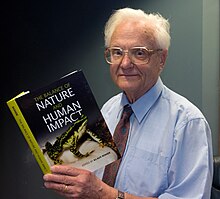|
Klaus Rohde
Klaus Rohde (born 30 March 1932) is a German biologist and parasitologist at the University of New England (UNE), Australia. He is known particularly for his work on marine parasitology, evolutionary ecology, zoogeography, phylogeny, and ultrastructure of lower invertebrates. Early life and educationKlaus Rohde was born in Brandenburg an der Havel, Germany, on 30 March 1932.[1] He attended the Saldria Gymnasium and Nikolai-Schule in Brandenburg, earning his Abitur in 1949. Rohde went on to study at the Teachers Training College in Brandenburg, receiving, in 1950, a Teacher's Diploma in Russian language. From 1950 to 1951, he studied Slavic languages at the University of Potsdam. Near the end of 1951 he moved from East to West Germany, enrolling at the University of Münster, studying botany, zoology, physics and physiological chemistry. Rohde undertook research for his PhD in 1954,[2] under the supervision of Berhard Rensch, a notable German zoologist;[3] his thesis was on the behaviour and physiology of Paramecium. In 1957 he was awarded his PhD, magna cum laude.[2] CareerFrom 1957 to 1959, he did scientific work at ASTA-Werke, Brackwede/Westfalen (pharmaceutical industry) on the development of new tests for screening anthelminthic drugs (filariasis, hookworms, cysticercus). From 1960 to 1967, Rohde was a lecturer at the University of Malaya, Kuala Lumpur, conducting work on the taxonomy, life cycles and fine structure of trematodes and monogeneans and supervising BSc. Honours, MSc. and PhD candidates. He participated in expeditions to various parts of Malaysia and visited many countries in Eastern, Southeastern, Southern Asia, and America. From 1967 to 1970 he was a Research Fellow (Habilitandenstipendiat) at the Ruhr University Bochum, Germany. Habilitation in Bochum was successfully concluded in 1970 with a thesis on the morphology, life cycle and ultrastructure of the aspidogastrean Multicotyle purvisi. He moved to Australia in 1970 to assume a two-year Postdoctoral Fellowship at the University of Queensland, Australia, with research on the taxonomy, ecology, life cycles and ultrastructure of the aspidogastrean Lobatostoma manteri and various monogenea. During this period, he visited the Great Barrier Reef as part of his work. In 1972 he was Reader in Zoology at the University of Khartoum, Sudan. 1973–1976 he was Director of the Heron Island Research Station, Great Barrier Reef, conducting research on the taxonomy and ecology of Monogenea and Aspidogastrea. The University of Queensland awarded him the degree of DSc. in 1975 for his parasitological and zoological work. In 1976 he was appointed Lecturer at the University of New England (UNE), Australia, subsequently promoted to Associate Professor and Professor (Personal Chair). In 2001 he became Professor emeritus. Research and workRohde's main research fields are fine structure, ecology, zoogeography, parasitology, and phylogeny of invertebrates, particularly of Aspidogastrea, Monogenea, Amphilinidea, and general aspects of ecology (niche theory, competition) and zoogeography (latitudinal gradients). He supervised many BSc.Honours, MSc. and PhD candidates in these fields, and, jointly with Tim Littlewood at the Natural History Museum London, Nikki Watson, UNE and others, studied the phylogeny of Platyhelminthes, using ultrastructure, life cycle and DNA data. His scientific contributions are on the following topics:
Rohde was the first who supplied quantitative evidence for the enormous species diversity of marine parasites in tropical (coral reef) waters, and for differences in latitudinal gradients between endo- and ectoparasites.[citation needed] His hypothesis of effective evolutionary time was an important stimulus for the development of the metabolic theory of ecology. His work on the phylogeny of Platyhelminthes provided evidence that the Neodermata (major groups of parasitic Platyhelminthes) have split early off the other flatworm groups. His demonstration of the great number and variety of sensory receptors and of the great complexity of nervous systems in some parasitic flatworms is convincing evidence that sacculinization (reduction in complexity) of parasites is not a general phenomenon. Rohde's work on the ecology of marine parasites has shown that most parasites live in largely non-saturated niche space, i.e., that most niches are vacant; proceeding from these findings, he concluded that equilibrium conditions in animal communities are the exception rather than the rule (discussed in detail in his book Nonequilibrium Ecology). After retirement he continues to publish scientific papers and books. He has cooperated with Dietrich Stauffer, a theoretical physicist, in using mathematical models to investigate latitudinal gradients in species diversity and niche width. He is running two blogs with articles and posts on science, politics and philosophy [5][6] Honors
Personal lifeRohde lived and worked in Münster/Westfalen (Germany), Brackwede/Bielefeld (Germany), Bochum (Germany), Kuala Lumpur (Malaysia), Khartoum (Sudan), Heron Island (Great Barrier Reef) and Brisbane (Australia). He now lives in Armidale (Australia). BibliographyRohde has published about 480 scientific papers in international journals and book chapters, as well as several books. Books
The first edition of Ecology of Marine Parasites, University of Queensland Press 1982, has been translated into Malay-Indonesian: Ekologi Parasit Laut, Dewan Bahasa dan Pustaka, Kuala Lumpur. Selected papers and book chapters
References
External links
|
||||||||||||||||||||||||||
